Cape Town, a jewel at the tip of the African continent, is a city that effortlessly combines natural beauty with rich cultural diversity. Framed by the iconic Table Mountain and bordered by the Atlantic Ocean, Cape Town’s landscapes are as varied as its cultural heritage. From the historic Robben Island to the bustling streets of the V&A Waterfront, the city offers many experiences that cater to nature lovers, history enthusiasts, and culinary adventurers. This guide offers insightful travel recommendations and aims to provide an insider’s perspective on exploring Cape Town, highlighting must-visit destinations and activities that showcase the city’s unique charm and complexity.
1. Table Mountain

Image Credit: Shutterstock / Andrea Willmore
Table Mountain is a landmark, defining the skyline of Cape Town with its distinctive flat top. This natural wonder is not just a spectacular backdrop but a vibrant ecosystem, home to over 1,500 species of plants, many of which are endemic to the area and cannot be found anywhere else in the world. The mountain’s accessibility allows visitors to explore its rich biodiversity and geological formations through various hiking trails that cater to all fitness and adventure levels. For those seeking a less strenuous visit, the Table Mountain Aerial Cableway provides a smooth ascent to the summit, offering panoramic views of Cape Town, the Atlantic Seaboard, and beyond. The top of the mountain is well-equipped with pathways, viewing decks, and facilities, ensuring that all visitors, regardless of how they reach the summit, can fully enjoy the breathtaking vistas and the unique flora. The presence of the dassie, or rock hyrax, a small creature related to the elephant, adds a charming element to the mountain’s wildlife. Table Mountain is a symbol of Cape Town’s environmental commitment, encapsulated in its status as a New 7Wonder of Nature.
Insider’s Tip: For a truly memorable experience, hike up the mountain via Platteklip Gorge at dawn and catch the sunrise over the city. The early start beats the crowds and provides cooler temperatures for the ascent.
When to Travel: The best time to visit Table Mountain is during the spring (September to November) or autumn months (March to May), when the weather is mild and the visibility is at its best.
How to Get There: Table Mountain is accessible via the Table Mountain Aerial Cableway or by hiking. The cableway station is a short drive from the city center, with parking available on Tafelberg Road.
2. Robben Island

Image Credit: Shutterstock / Darrenp
Robben Island, a somber yet profoundly inspiring symbol of South Africa’s struggle for freedom, sits just off the coast of Cape Town. This UNESCO World Heritage site has served various roles throughout its history, including a prison, a hospital, and a military base, but it is most renowned for being the place where Nelson Mandela and other political prisoners were incarcerated during apartheid. A visit to Robben Island offers a moving insight into the resilience and courage of those who fought for South Africa’s democracy. Often led by former political prisoners, the tour provides an authentic and personal perspective on the hardships endured and the spirit of forgiveness and reconciliation that emerged. The island itself, with its stark landscapes and poignant historical sites, including Mandela’s tiny cell, stands as a powerful reminder of the human capacity for endurance and hope. Beyond its historical significance, Robben Island is also a place of unique biodiversity and conservation efforts. It is home to various bird species and marine life, making it a compelling visit for those interested in history and nature.
Insider’s Tip: Book your tickets in advance, especially during peak tourist season, to ensure your spot on the tour. The ferry ride to the island also offers a unique perspective of Cape Town from the sea.
When to Travel: The weather is most favorable from September to May, offering clearer skies and smoother ferry rides to the island.
How to Get There: Ferries to Robben Island depart from the Nelson Mandela Gateway at the V&A Waterfront. It’s advisable to arrive early for security checks and boarding.
3. Kirstenbosch National Botanical Garden
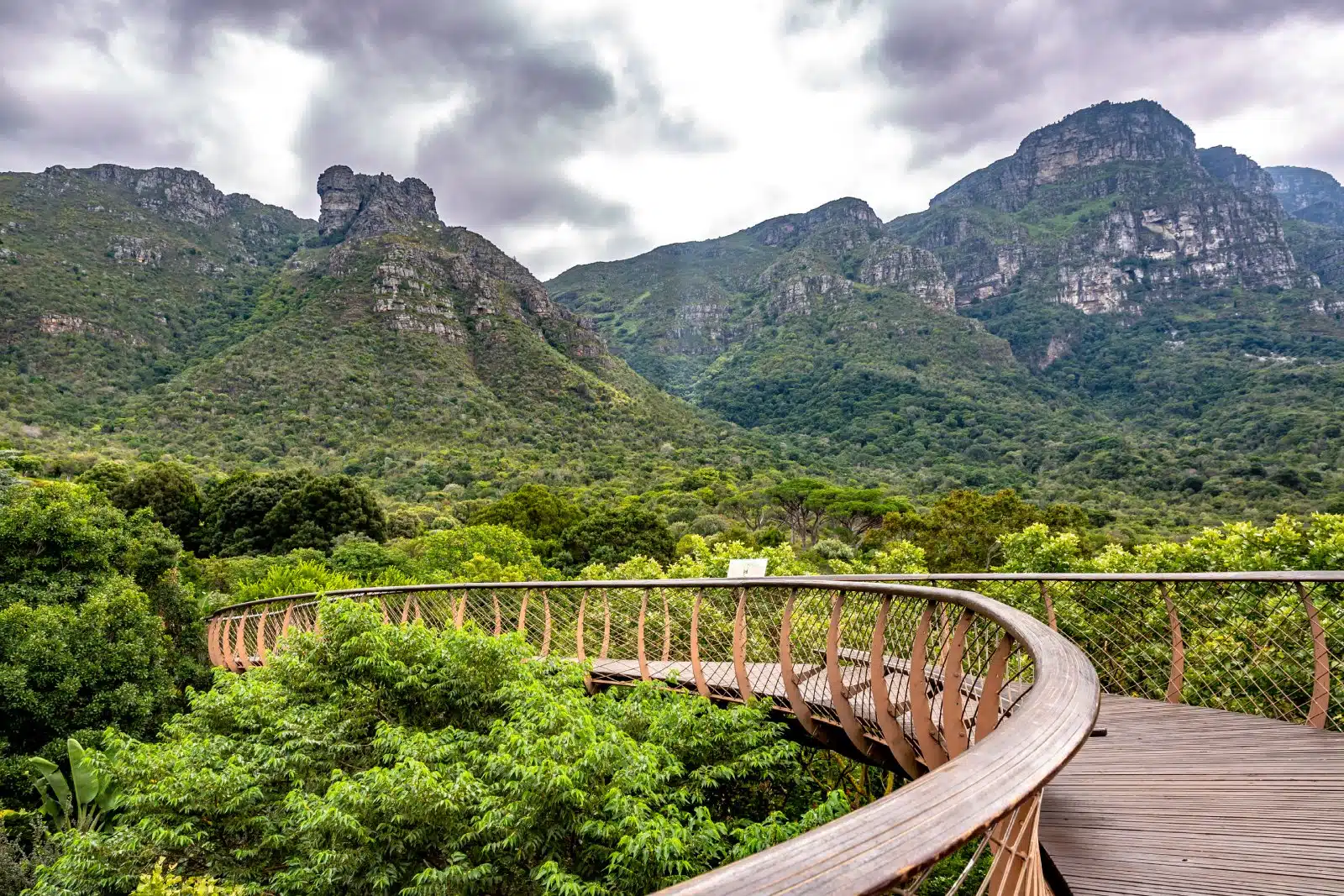
Image Credit: Shutterstock / Finn stock
Kirstenbosch National Botanical Garden, nestled at the foot of Table Mountain, is a magnificent showcase of South Africa’s diverse flora. Established in 1913 to preserve the country’s unique plant life, the garden spans 528 hectares and features plants from the Cape Floristic Region and various other species from different parts of South Africa. The garden’s layout blends seamlessly with the natural landscape, offering visitors a tranquil and immersive experience. Highlights include the Protea Garden, which blooms with South Africa’s national flower; the Fragrance Garden, filled with scented plants; and the Medicinal Garden, showcasing plants used in traditional African medicine. The Centenary Tree Canopy Walkway, affectionately known as the “Boomslang,” winds through the treetops, offering unparalleled views of the gardens and mountains. Kirstenbosch is a botanical research and conservation center, crucial in preserving the region’s unique biodiversity. Its blend of scientific importance and natural beauty makes it a must-visit for anyone interested in the rich botanical heritage of South Africa.
Insider’s Tip: Don’t miss the “Boomslang” canopy walkway that offers an elevated view of the gardens and the mountain. Visit during the early morning to enjoy the gardens in serene solitude.
When to Travel: While Kirstenbosch is beautiful year-round, visiting during the spring (August to November) will allow you to see the wildflowers in full bloom.
How to Get There: Kirstenbosch is located about 13 kilometers from the city center. It can be reached by car, taxi, or tour bus. Parking is available on site.
4. Cape Point
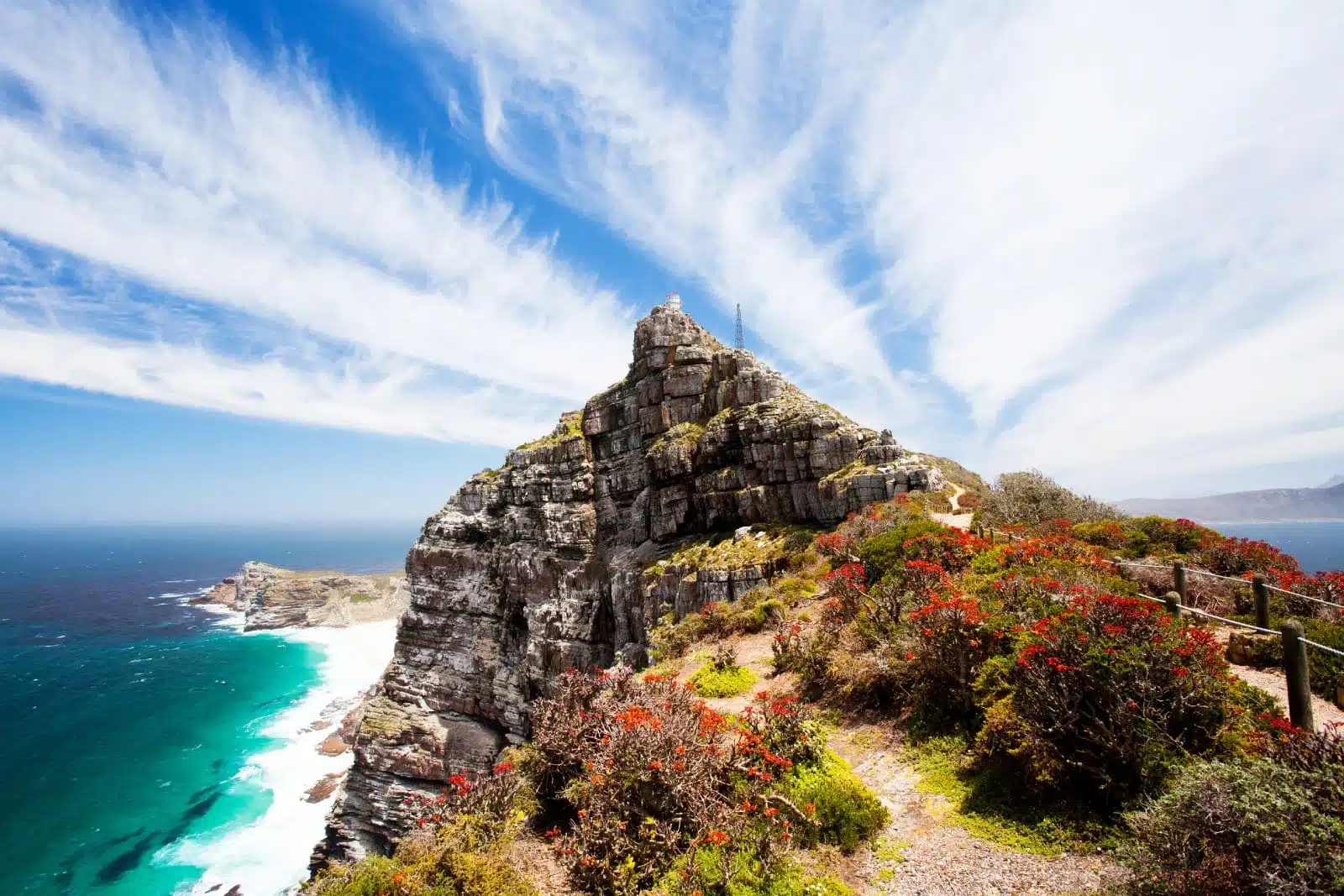
Image Credit: Shutterstock / michaeljung
Cape Point, located within the Table Mountain National Park, is a rugged and breathtakingly scenic promontory at the tip of the Cape Peninsula. This remote and wild section of the park is characterized by steep cliffs, diverse flora and fauna, and sweeping ocean views that are nothing short of spectacular. Cape Point is often mistaken as the meeting point of the Atlantic and Indian Oceans, a title that officially belongs to Cape Agulhas further south, but this does not detract from its dramatic beauty and the sense of isolation one feels standing at the edge of this vast continent. The area is rich in maritime history, with the old lighthouse standing as a sentinel over the treacherous waters that have claimed many ships over the centuries. Visitors can explore numerous hiking trails that crisscross the landscape, offering opportunities to encounter baboons, ostriches, and a variety of bird species. The Flying Dutchman Funicular provides an alternative to walking, taking guests to the lighthouse for those panoramic views. Cape Point’s wild, natural beauty is a powerful reminder of the forces that shape our world and a highlight of any visit to Cape Town.
Insider’s Tip: Take the Flying Dutchman Funicular to the old lighthouse for breathtaking panoramic views. Early morning visits are recommended to avoid the crowds and to catch the wildlife in their most active state.
When to Travel: The best time to visit Cape Point is during the spring and early summer months (September to December) when the weather is pleasant and the wildflowers are in bloom.
How to Get There: Cape Point is about a 1.5-hour drive from Cape Town. The scenic route via Chapman’s Peak Drive is highly recommended for its stunning ocean views.
5. The V&A Waterfront
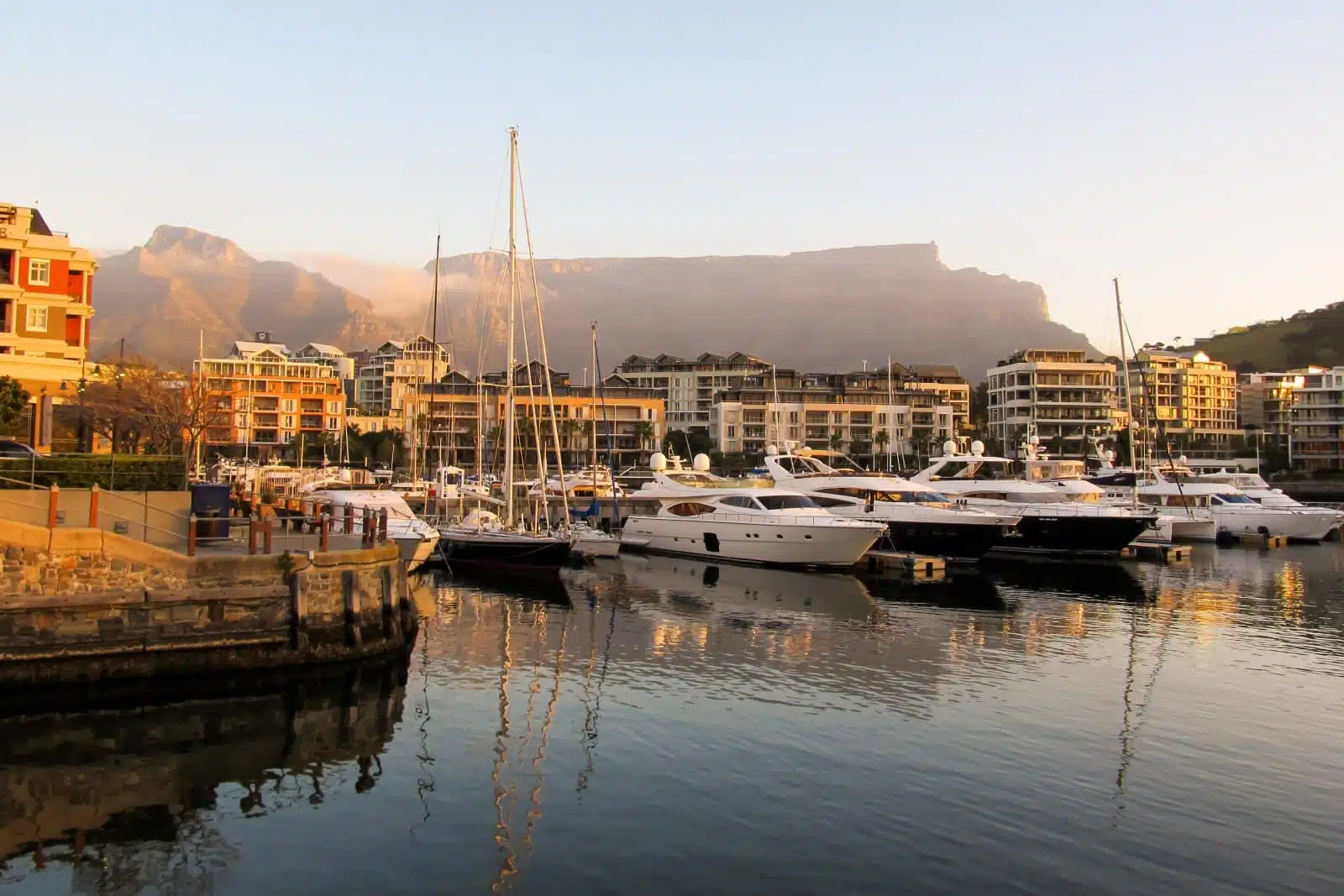
Image Credit: Shutterstock / Marieke Peche
The Victoria & Alfred Waterfront, named after Queen Victoria and her son Alfred, who initiated its construction in the 19th century, is a vibrant fusion of shopping, dining, and entertainment set against a working harbor and the stunning Table Mountain. This bustling waterfront district is one of Cape Town’s most visited destinations, attracting millions of visitors yearly. The area’s rich historical heritage is preserved in the restored Victorian-era buildings, which now house various shops, restaurants, and museums, including the Zeitz Museum of Contemporary Art Africa (MOCAA), the world’s largest museum of contemporary African art. The V&A Waterfront is also a departure point for boat tours to Robben Island, adding a layer of historical significance to its lively atmosphere. The Waterfront is a hub for ocean-going adventures, including yacht charters, harbor cruises, and even helicopter tours, providing unique perspectives of Cape Town’s breathtaking scenery. Whether exploring the food market for local delicacies, enjoying live music and street performances, or simply soaking in the views, the Waterfront encapsulates the dynamic spirit of Cape Town.
Insider’s Tip: Explore the lesser-known parts of the Waterfront, such as the Breakwater Prison and the Chavonnes Battery Museum, for a glimpse into Cape Town’s past.
When to Travel: The Waterfront is a year-round destination, with each season offering different attractions, from summer concerts to winter culinary experiences.
How to Get There: Located in the heart of Cape Town, the Waterfront is easily accessible by foot from the city center, or by car, taxi, and public transport.
6. Boulders Beach
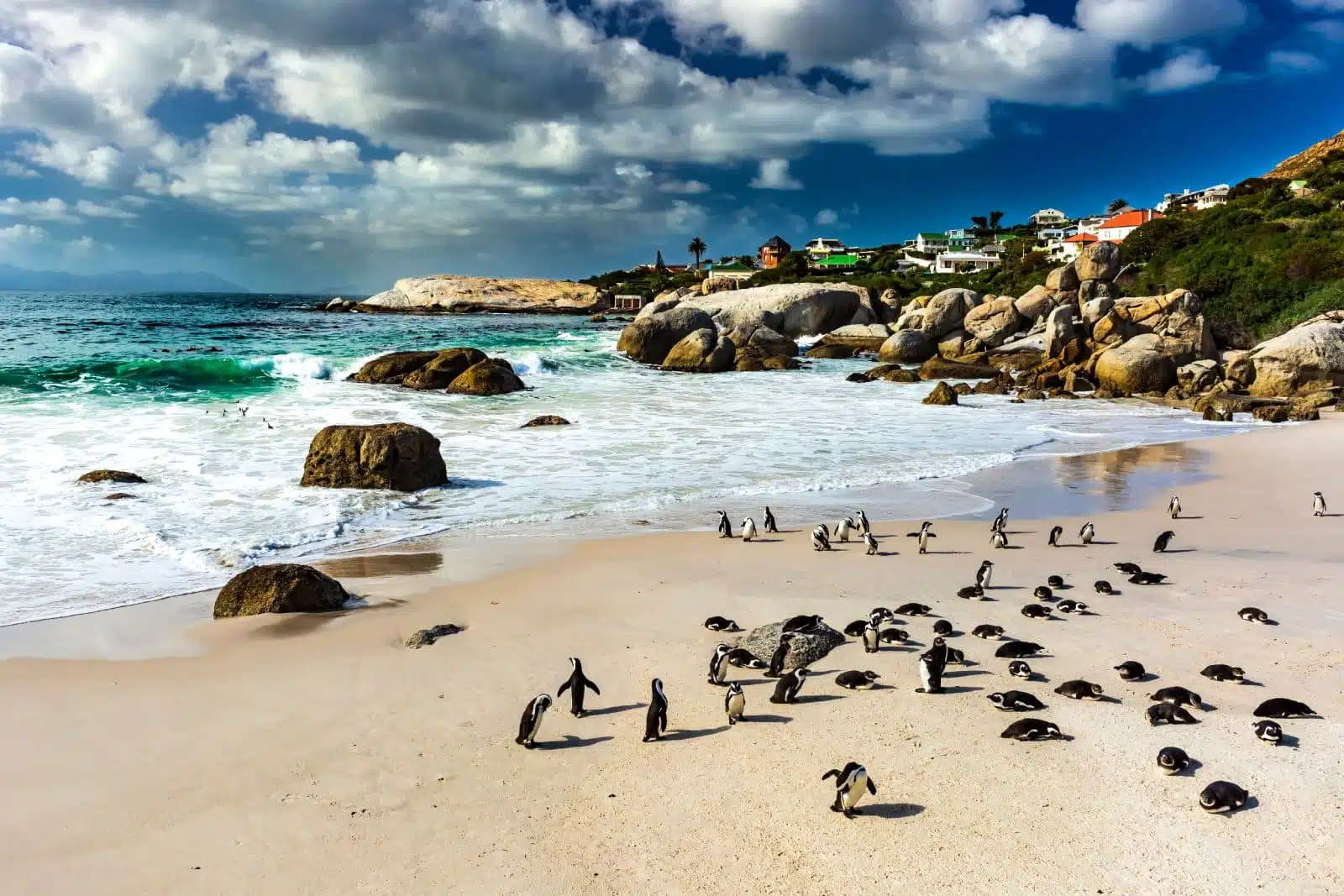
Image Credit: Shutterstock / AlexKonst
Boulders Beach, renowned for its idyllic scenery and the unique experience of being up close with African penguins, is a conservation success story in the quaint suburb of Simon’s Town. The beach is part of the Table Mountain National Park Marine Protected Area, ensuring the safety and preservation of its feathered inhabitants. The sheltered bays, with soft white sand and granite boulders that are millions of years old, create a serene environment for the penguins and visitors. The boardwalks leading to the viewing areas minimize human impact on the penguin colony, allowing for intimate observations of these creatures in their natural habitat., Boulders Beach offers excellent swimming in the warmer waters of False Bay, making it a perfect spot for families. The water’s clarity and the beach’s sheltered aspect also make it an ideal location for snorkeling, offering a glimpse into the area’s rich marine life. Boulders Beach represents a delicate balance between tourism and conservation, offering a unique opportunity to engage with nature responsibly and sustainably.
Insider’s Tip: Visit early in the morning or late in the afternoon to avoid the crowds and to see the penguins during their most active periods.
When to Travel: Penguin viewing is excellent year-round, but the breeding season from February to May offers a special glimpse into their nesting behaviors.
How to Get There: Boulders Beach is located near Simon’s Town, about an hour’s drive from Cape Town’s city center. Public transport options are available, but a car provides the most flexibility.
7. Bo-Kaap
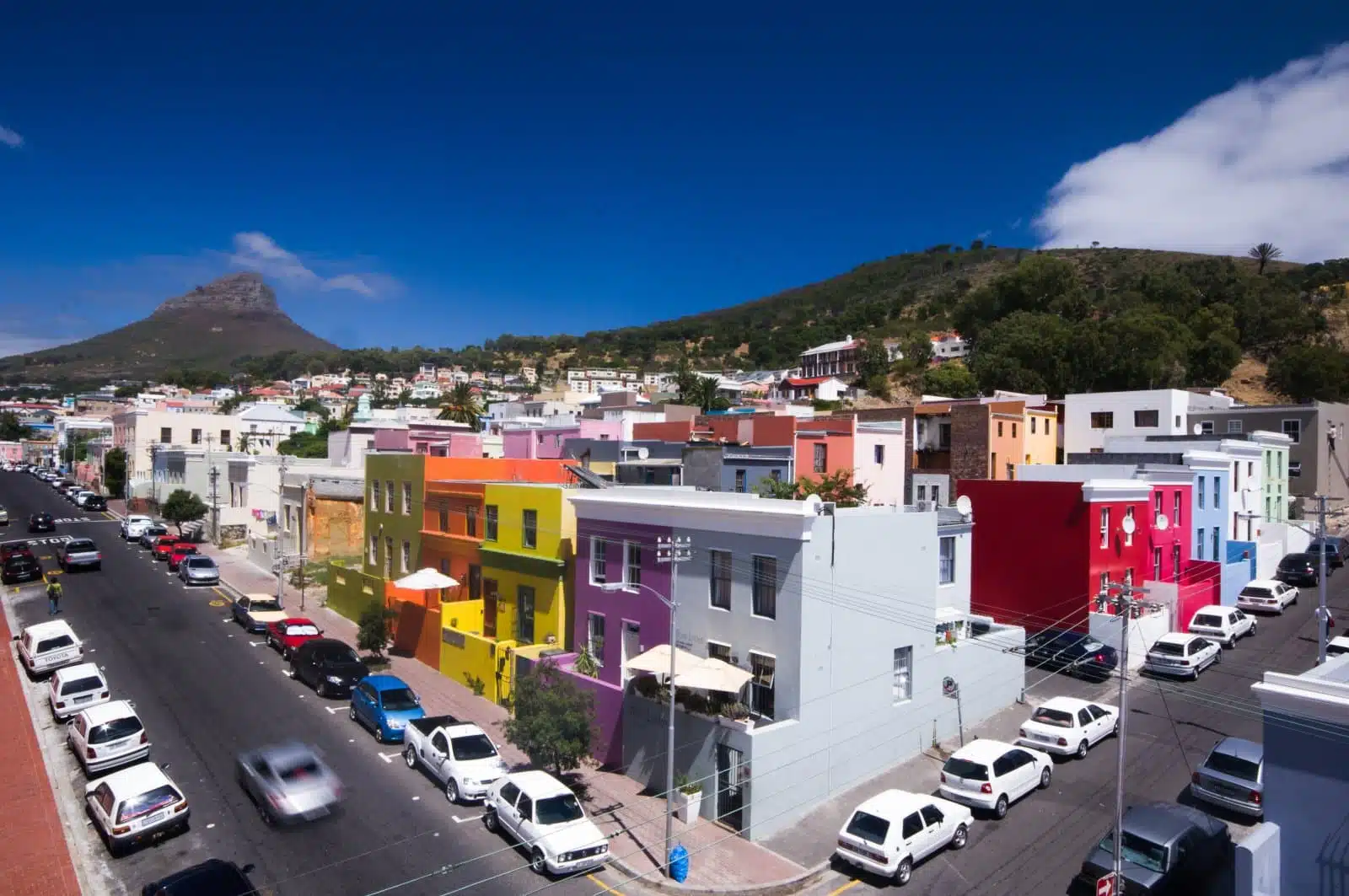
Image Credit: Shutterstock / LongJon
The Bo-Kaap, with its brightly colored houses and cobbled streets, highlights Cape Town’s multicultural history. This neighborhood, situated on the slopes of Signal Hill, is historically significant as the former township of Cape enslaved Malays in the 18th century. Today, it is celebrated for its rich cultural heritage, including its distinctive Cape Malay cuisine, which visitors can explore through various cooking tours and restaurants. The Bo-Kaap Museum, located in one of the oldest buildings in the area, offers insights into the life of a typical Malay family in the 19th century, providing context to the area’s architectural and social history. The annual Cape Malay Choir Parade and other cultural festivals bring the streets of Bo-Kaap to life, showcasing the vibrant community spirit and traditions that have been preserved over generations. Walking through Bo-Kaap is an immersive experience, offering visual delight with its palette of brightly painted homes and a deeper understanding of the complex layers of Cape Town’s social and cultural fabric.
Insider’s Tip: Explore the area on foot to fully appreciate the architecture and visit the Bo-Kaap Museum to delve into the local history.
When to Travel: The Bo-Kaap is vibrant throughout the year, but visiting during the Islamic holy month of Ramadan offers a unique insight into the community’s traditions.
How to Get There: The Bo-Kaap is centrally located and easily accessible on foot from downtown Cape Town, or by taxi.
8. Constantia Wine Route
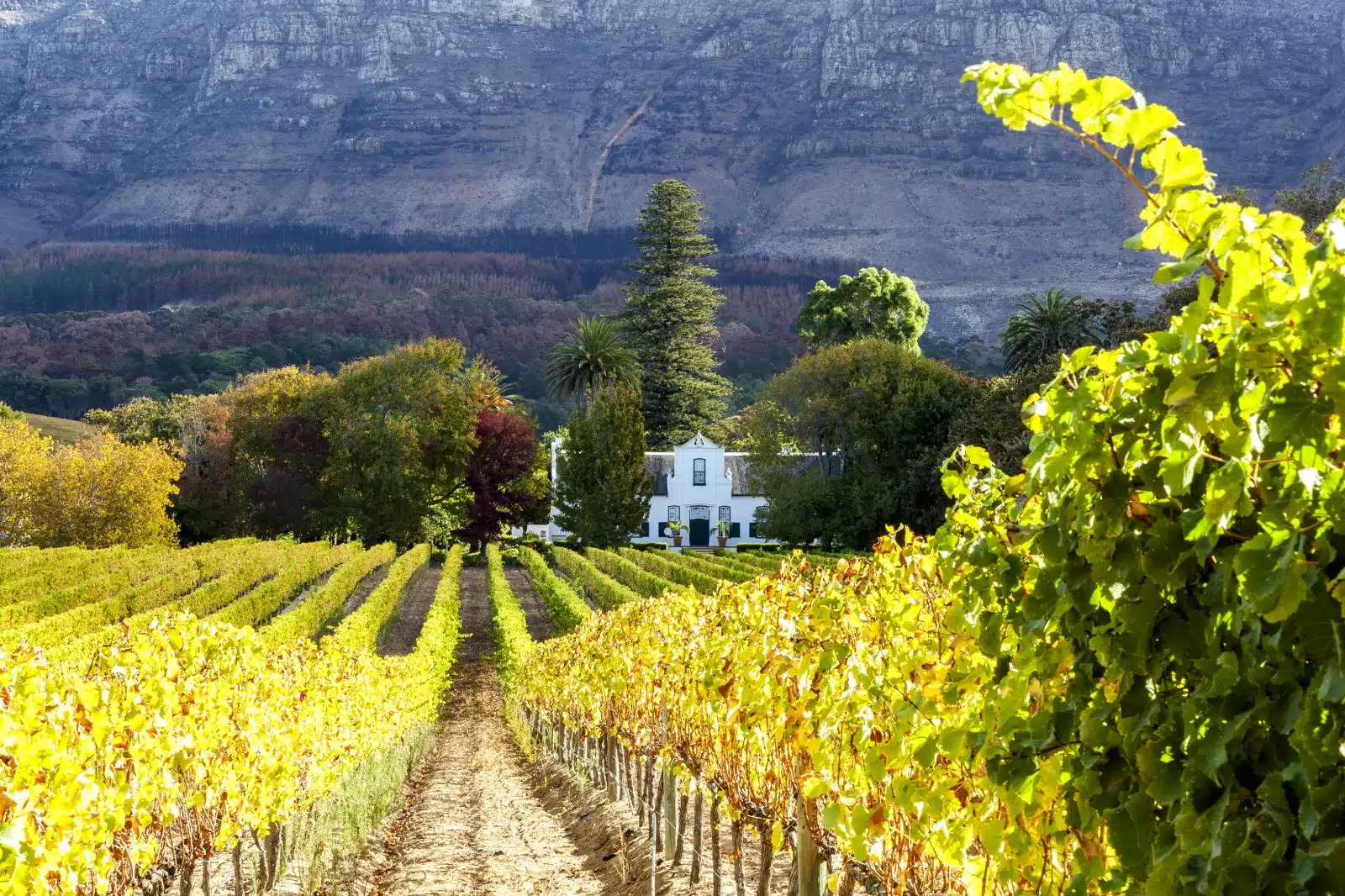
Image Credit: Shutterstock / Ilonde van Hoolwerff
The Constantia Wine Route, set against the Constantiaberg mountain, is the oldest wine-producing region in the Southern Hemisphere, with roots stretching back to 1685. This prestigious wine route is celebrated for its award-winning vineyards and historic wine estates that combine to offer an unparalleled wine-tasting experience. The lush, verdant valleys of Constantia are home to some of South Africa’s most acclaimed wines, including world-renowned dessert wines that connoisseurs and royalty alike have praised. Each estate along the route has its unique charm, from modern tasting rooms with panoramic views to historic manor houses surrounded by ancient oaks. The Constantia Wine Route is a culinary journey, with many estates offering fine dining restaurants that highlight local and seasonal produce perfectly paired with their wines. The area’s natural beauty, with meticulously landscaped gardens and sweeping vineyard views, makes it a favorite for locals and visitors seeking a tranquil escape with a taste of South Africa’s wine heritage.
Insider’s Tip: Many estates offer gourmet dining experiences that pair beautifully with their wines. Booking a lunch or dinner with wine pairing is a must.
When to Travel: Late summer and autumn (February to May) are ideal for wine tasting, as the weather is pleasant and the grape harvest is in full swing.
How to Get There: Constantia is about a 20-minute drive from the city center. While public transport is an option, hiring a car or booking a wine tour allows for a more comprehensive experience.
9. Lion’s Head
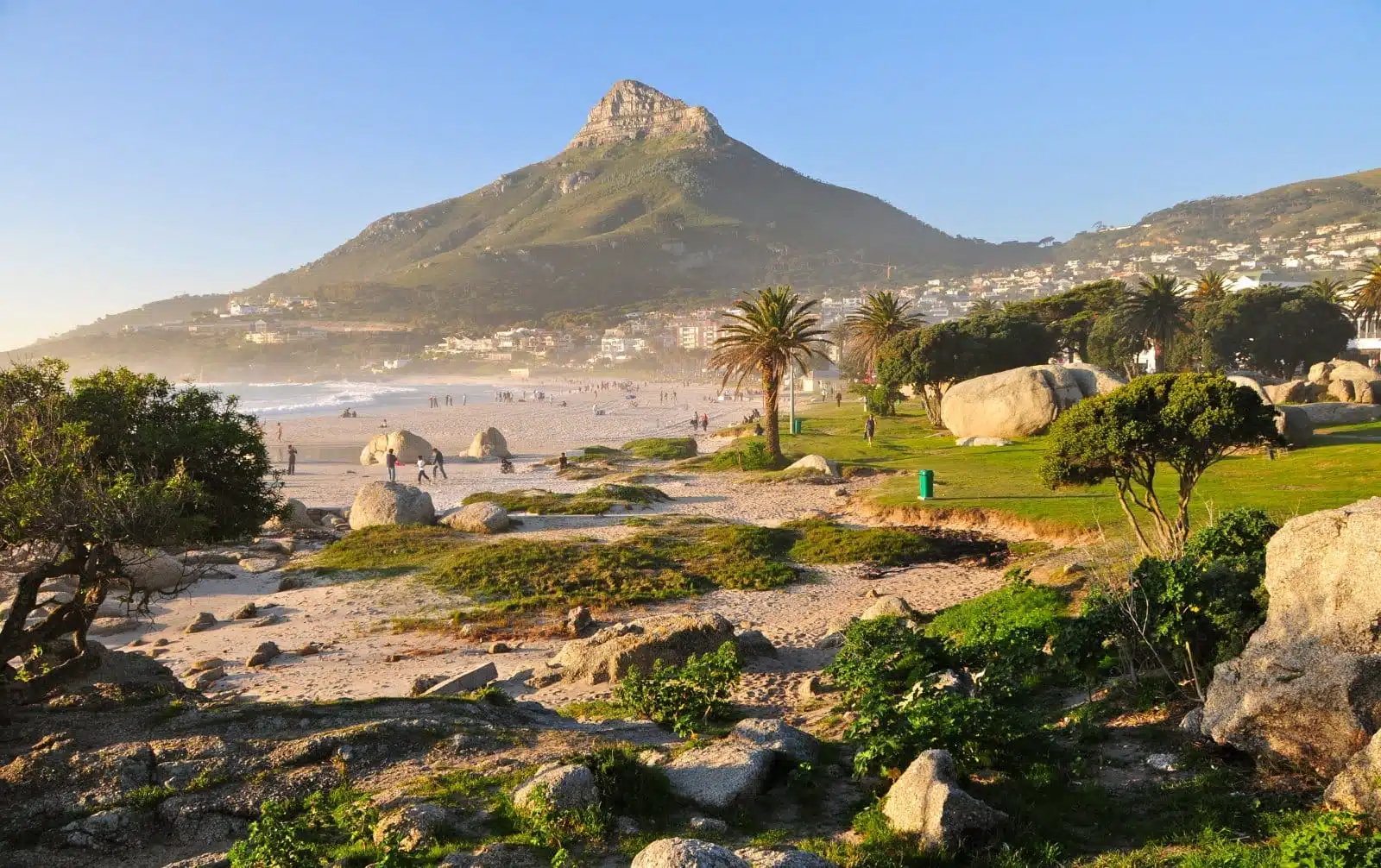
Image Credit: Shutterstock / Richard Cavalleri
Lion’s Head, a prominent peak beside Table Mountain, offers one of the most spectacular vantage points over Cape Town, the Atlantic Seaboard, and beyond. The peak derives its name from its resemblance to a crouching lion, adding a mythic dimension to its already striking presence. The spiral path to the summit winds through unique fynbos vegetation, showcasing the biodiversity of the Cape Floristic Region. The hike to the top of Lion’s Head is relatively accessible, making it a popular choice for dawn and dusk excursions when the play of light transforms the panoramic views into a breathtaking spectacle. The full moon hike to Lion’s Head has become a tradition for many Capetonians and visitors, offering a unique nocturnal perspective of the city lights against the natural silhouette of the mountain. Paragliding from the summit provides an adrenaline-fueled alternative for experiencing the stunning landscapes from above. Lion’s Head serves as a natural landmark that embodies the adventurous spirit of Cape Town, offering a blend of accessible outdoor activity, ecological beauty, and unparalleled views.
Insider’s Tip: For a less crowded experience, consider hiking during the full moon. The moonlit path and the city lights create a magical atmosphere.
When to Travel: The hike is accessible year-round, but the cooler months (May to September) offer a more comfortable climbing condition.
How to Get There: Lion’s Head is centrally located and accessible by car. Parking is available along Signal Hill Road, from where the trail starts.
10. District Six Museum
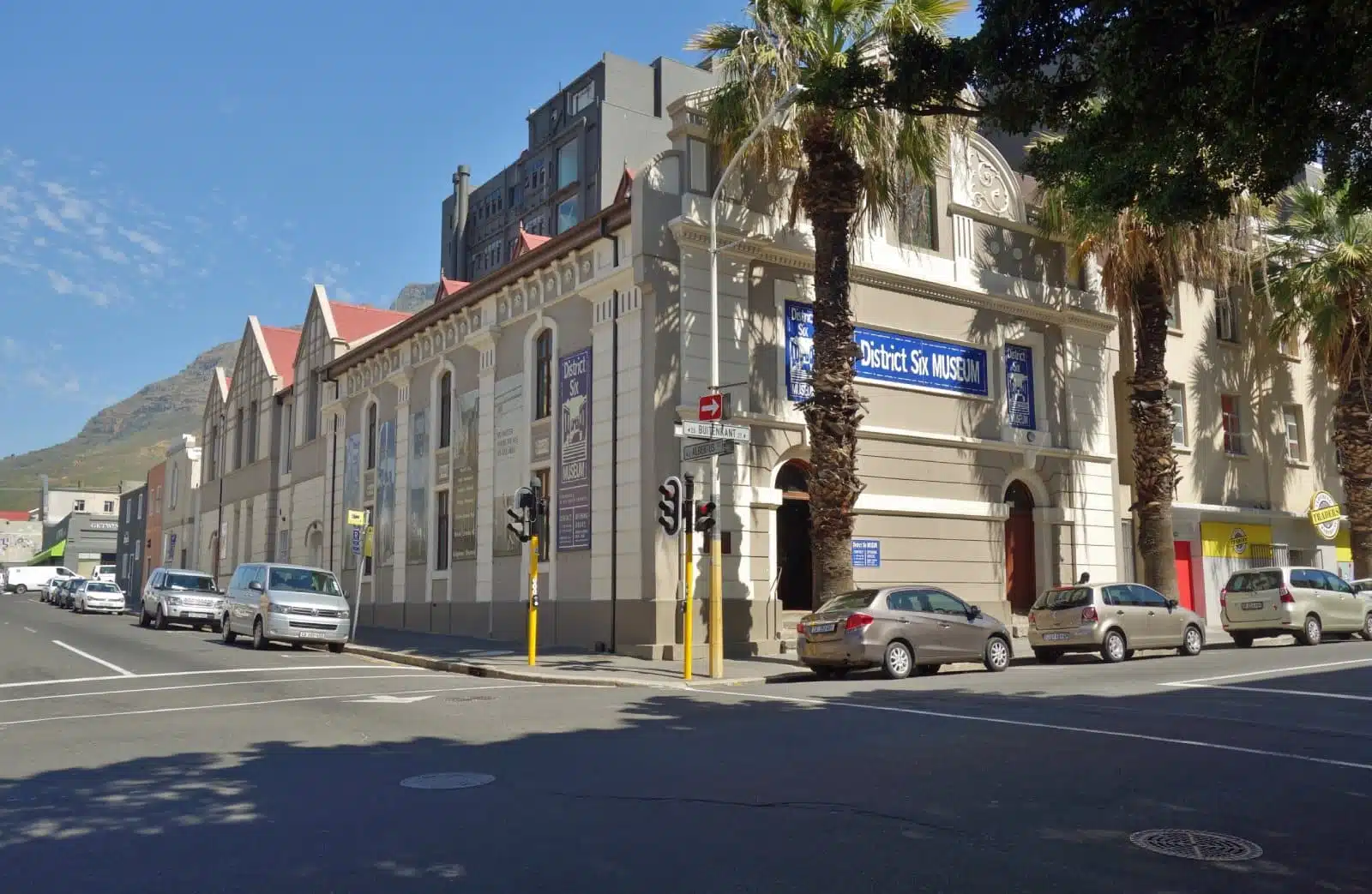
Image Credit: Shutterstock / EQRoy
The District Six Museum is a reminder of the forced removals that took place during apartheid, when over 60,000 residents were evicted from their homes in the District Six area, based on racial classifications. Established in 1994, the museum is in a former Methodist Mission Church, a significant choice that reflects the community’s resilience and spirit. The exhibits, curated with contributions from former residents, include photographs, personal artifacts, and interactive displays that tell the stories of displacement, resistance, and hope. The museum documents District Six’s history and serves as a space for reconciliation, where memories are preserved and the community’s cultural heritage is celebrated. It plays a crucial role in educating visitors about South Africa’s apartheid past while promoting dialogue and understanding. The District Six Museum is more than a collection of exhibits; it is a living memorial that honors the spirit of a community torn apart but not forgotten by segregation. Through its educational programs and community engagement, the museum advocates for social justice and urban restitution in Cape Town and beyond.
Insider’s Tip: Join a guided tour led by former residents to gain personal insights into the history and impact of the forced removals.
When to Travel: The museum is open year-round, but visiting during quieter months (May to September) can offer a more intimate experience.
How to Get There: The District Six Museum is located in the city center, easily accessible on foot, by bus, or taxi from major points in Cape Town.
11. Greenmarket Square
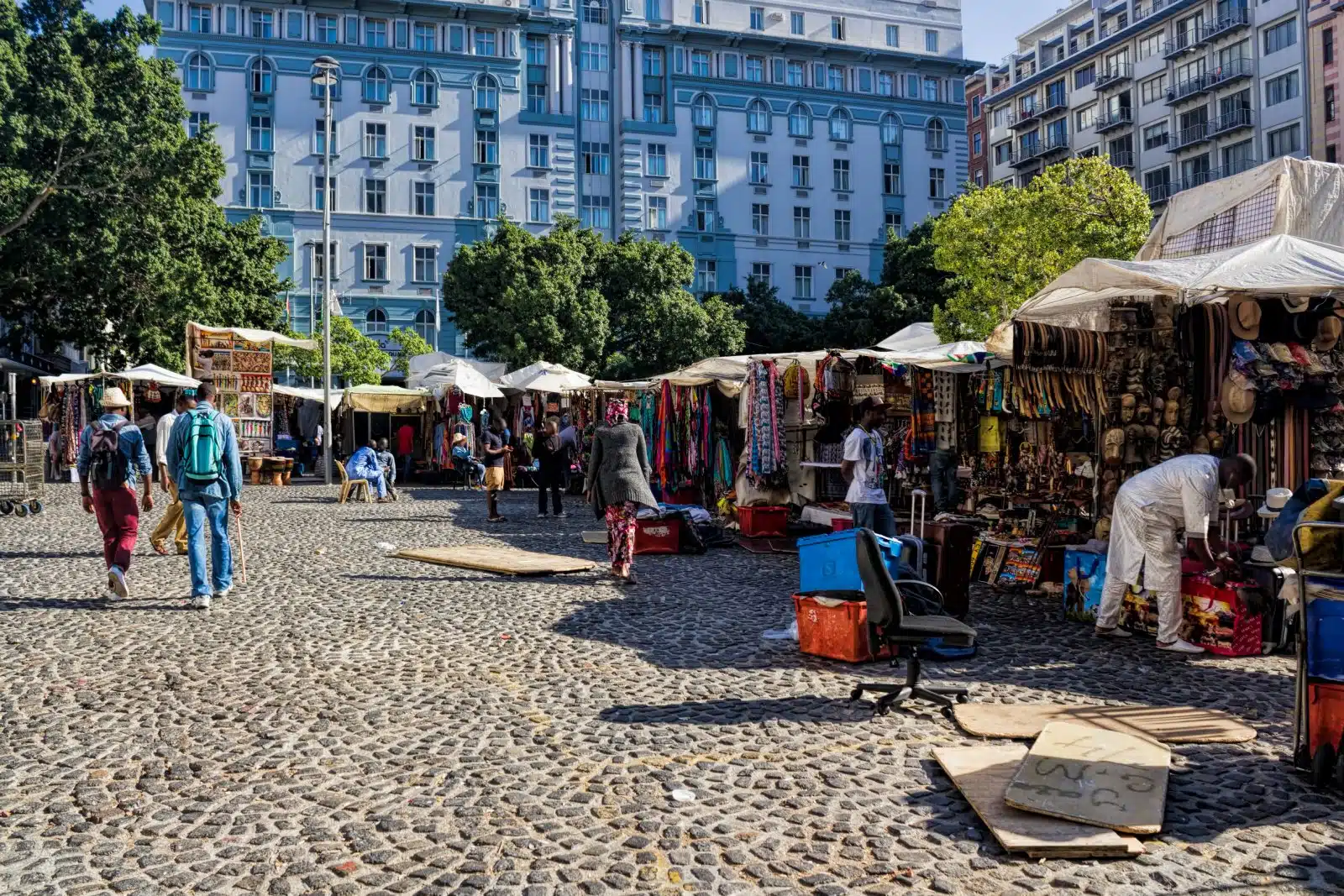
Image Credit: Shutterstock / ArTono
Greenmarket Square is one of the city’s oldest and most vibrant markets in the heart of Cape Town’s central business district. Established in 1696, this historic square has served various roles, from a slave market to a fruit and vegetable market, and today, it is a bustling hub of culture and commerce. The cobbled square is surrounded by historic buildings, reflecting the architectural heritage of Cape Town. Artisans, crafters, and traders come from all over the continent to sell their wares, including traditional African art, handmade jewelry, clothing, and souvenirs. The lively atmosphere is enhanced by street performers, musicians, and cafes lining the square, making it a popular spot for locals and tourists. Greenmarket Square offers an opportunity to engage with Africa’s diverse cultures and find unique, handcrafted items. It’s a place where the spirit of Cape Town’s past and present converge, offering a vibrant, sensory experience of the city’s cultural mosaic.
Insider’s Tip: Haggle respectfully with vendors to get the best deals. Early mornings are the best time to visit when the market is less crowded, and you can enjoy the first pick of the day’s offerings.
When to Travel: The market is open year-round, but visiting during the summer months (November to February) allows you to enjoy Cape Town’s sunny weather as you browse the stalls.
How to Get There: Greenmarket Square is easily accessible on foot from many points within Cape Town’s city center, or by taxi and public transport from further afield.
12. The Old Biscuit Mill
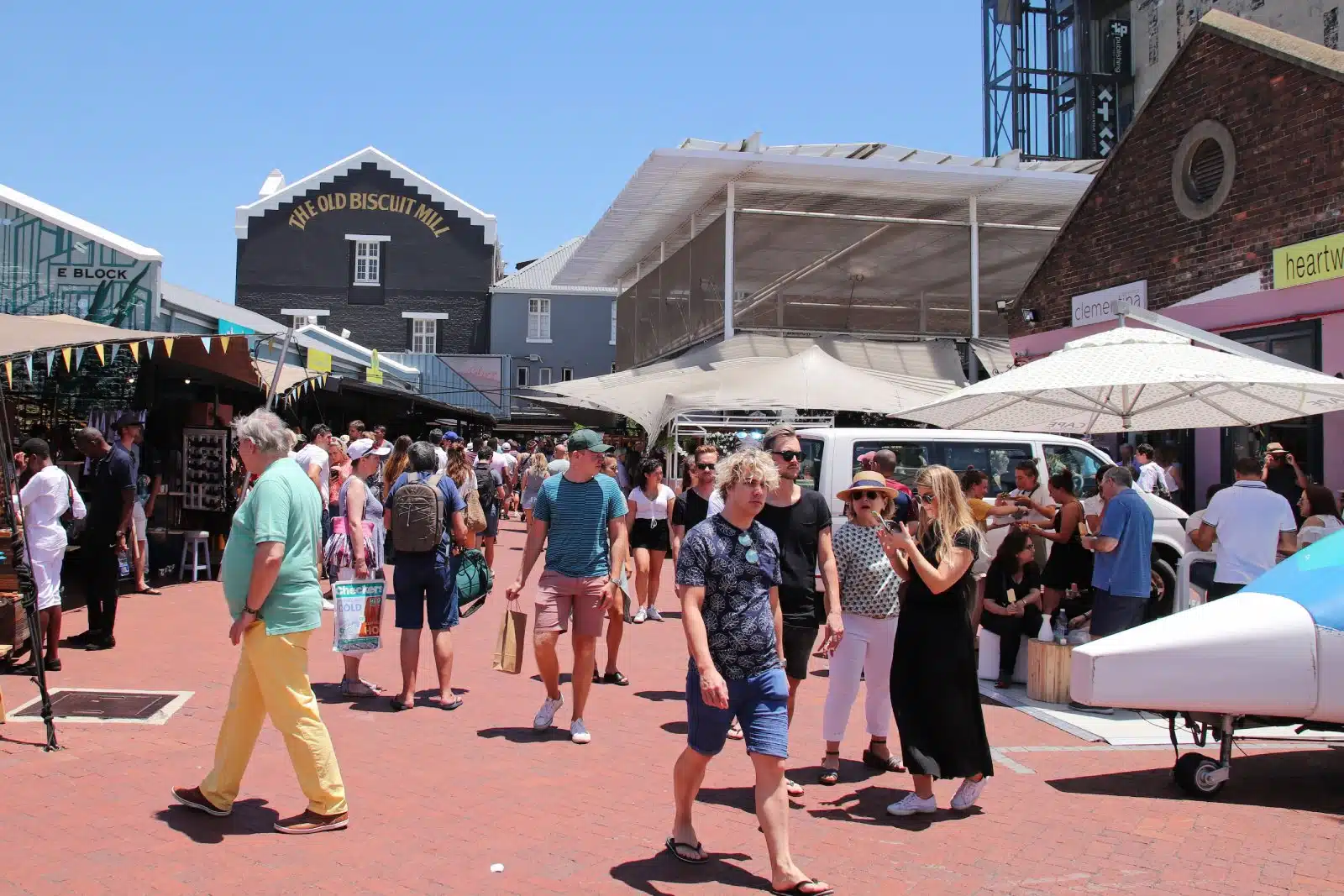
Image Credit: Shutterstock / MD_Photography
The Old Biscuit Mill, located in the vibrant neighborhood of Woodstock, has transformed from an industrial biscuit factory into a dynamic hub of creativity, cuisine, and culture. This eclectic space brings together artisans, designers, and culinary talents, offering Cape Town a unique shopping and dining experience. On weekends, the Neighbourgoods Market comes alive with various food stalls showcasing local and international flavors, artisanal goods, and live music, creating a festive atmosphere. The Old Biscuit Mill is also home to some of Cape Town’s most innovative restaurants, including the renowned Test Kitchen, which offers a gastronomic journey led by chef Luke Dale-Roberts. Art galleries, fashion boutiques, and design studios populate the rest of the space, making it a focal point for those seeking to explore Cape Town’s contemporary creative scene. The Old Biscuit Mill embodies the city’s spirit of innovation and its ability to repurpose historical spaces into vibrant community centers.
Insider’s Tip: Make sure to visit on a Saturday morning when the Neighbourgoods Market is in full swing, offering an array of local foods, crafts, and live music.
When to Travel: Saturdays are the best day to experience the full vibrancy of The Old Biscuit Mill, especially during the spring and summer months when the weather is most pleasant.
How to Get There: Located in the Woodstock area, The Old Biscuit Mill is best reached by car or taxi from the city center. Public transport options are also available but may require a short walk.
13. Clifton Beaches
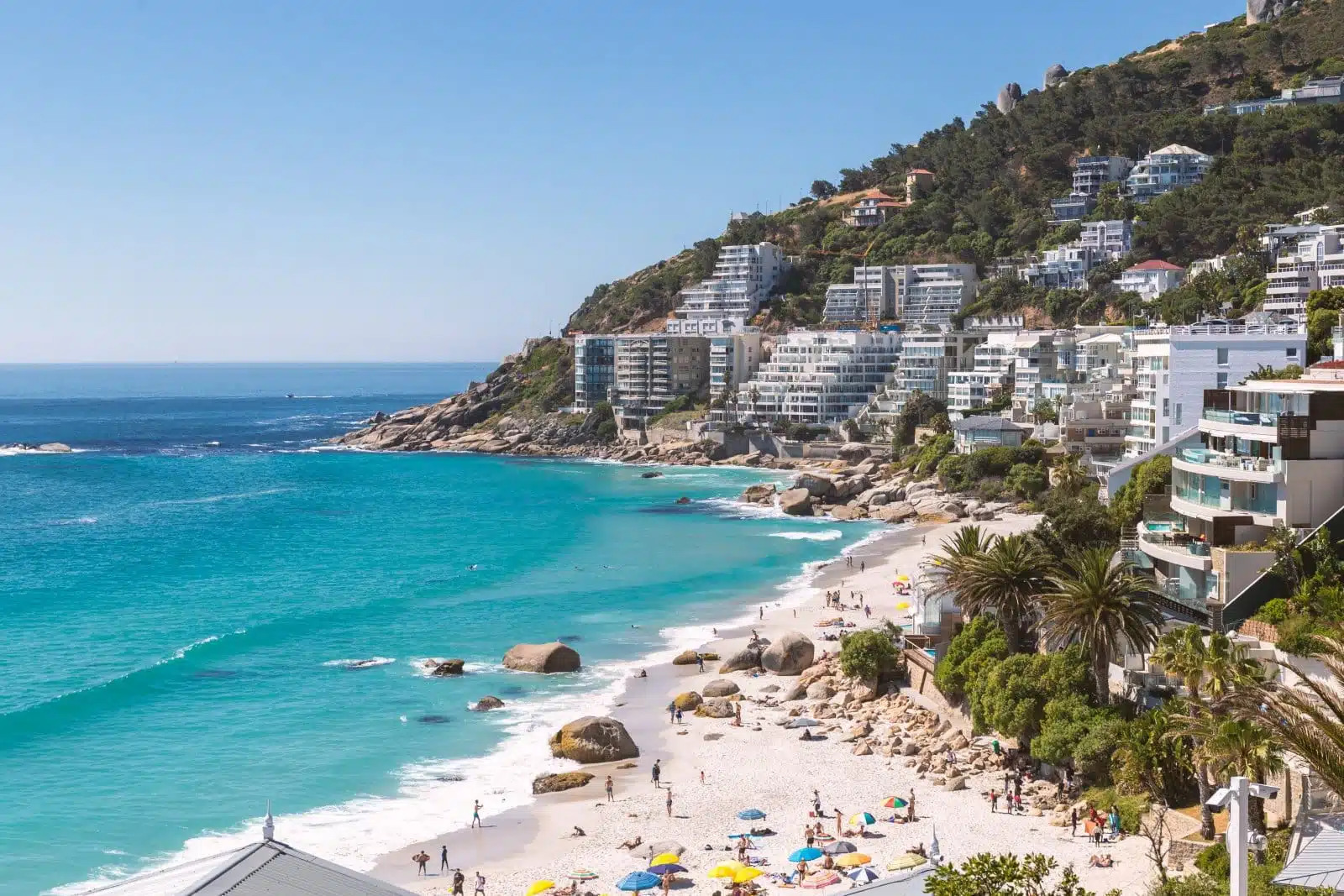
Image Credit: Shutterstock / Dmitrii Sakharov
The Clifton Beaches, nestled at the base of Lion’s Head, are among Cape Town’s most picturesque and exclusive coastal spots. Divided into four coves by granite boulders, each beach (Clifton 1st to 4th) has its own unique charm and atmosphere, catering to different crowds, from families and fitness enthusiasts to the city’s social elite. The white sandy beaches and crystal-clear waters offer a tranquil escape from the bustling city, with spectacular sunsets that draw locals and tourists alike. Despite the chilly Atlantic waters, Clifton’s beaches are a popular destination for sunbathing, beach volleyball, and picnics. The sheltered coves provide protection from the wind, making them enjoyable year-round. The accessibility of these beaches, combined with their natural beauty and the backdrop of Table Mountain, makes Clifton a quintessential Cape Town experience, embodying the city’s laid-back lifestyle and its stunning natural landscapes.
Insider’s Tip: Clifton 4th Beach is the most popular and family-friendly, but for a quieter experience, try Clifton 2nd or 3rd Beach. Remember to bring a windbreaker, as the beaches can be windy.
When to Travel: The best time to visit is during the summer months (November to February) when the weather is warm and sunny, perfect for beach days.
How to Get There: The Clifton Beaches are accessible by car or taxi from Cape Town’s city center. Limited parking is available along Victoria Road, so arriving early or later in the afternoon is advisable.
14. Signal Hill
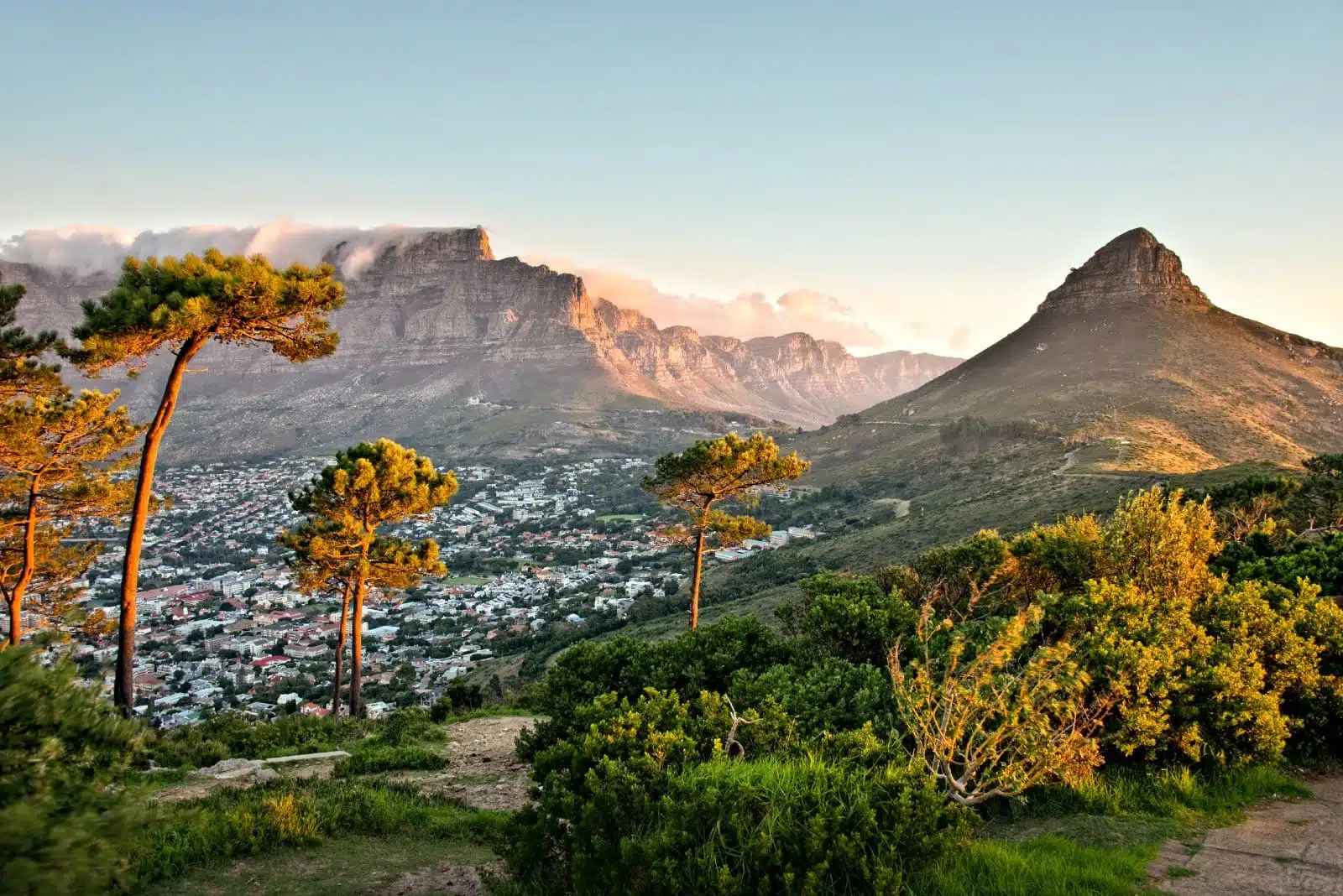
Image Credit: Shutterstock / Delpixel
Signal Hill is a natural amphitheater to Cape Town’s skyline, offering panoramic views stretching from the city bowl to the Atlantic Ocean. Beyond its daily Noon Gun tradition, Signal Hill is a beloved spot for locals and visitors to gather and watch the sunset, with the city lights and Table Mountain creating a stunning backdrop. The hill is also a starting point for paragliders, who take off to glide over the city and land on the beaches below, offering an adrenaline rush with unparalleled views. At night, Signal Hill becomes a popular spot for stargazing, with the city’s lights twinkling below. The accessibility of Signal Hill, combined with its natural beauty and various activities, makes it a versatile destination that encapsulates the essence of Cape Town’s outdoor lifestyle.
Insider’s Tip: For a unique experience, join a sunset picnic at Signal Hill. Bring a blanket, some snacks, and enjoy the breathtaking views as the sun dips below the horizon.
When to Travel: Signal Hill is accessible and enjoyable year-round, but the sunsets are spectacular during summer.
How to Get There: Signal Hill is a short drive from Cape Town’s city center. While public transport is available, driving or taking a taxi allows for more flexibility, especially when visiting in the evening.
15. Zeitz MOCAA
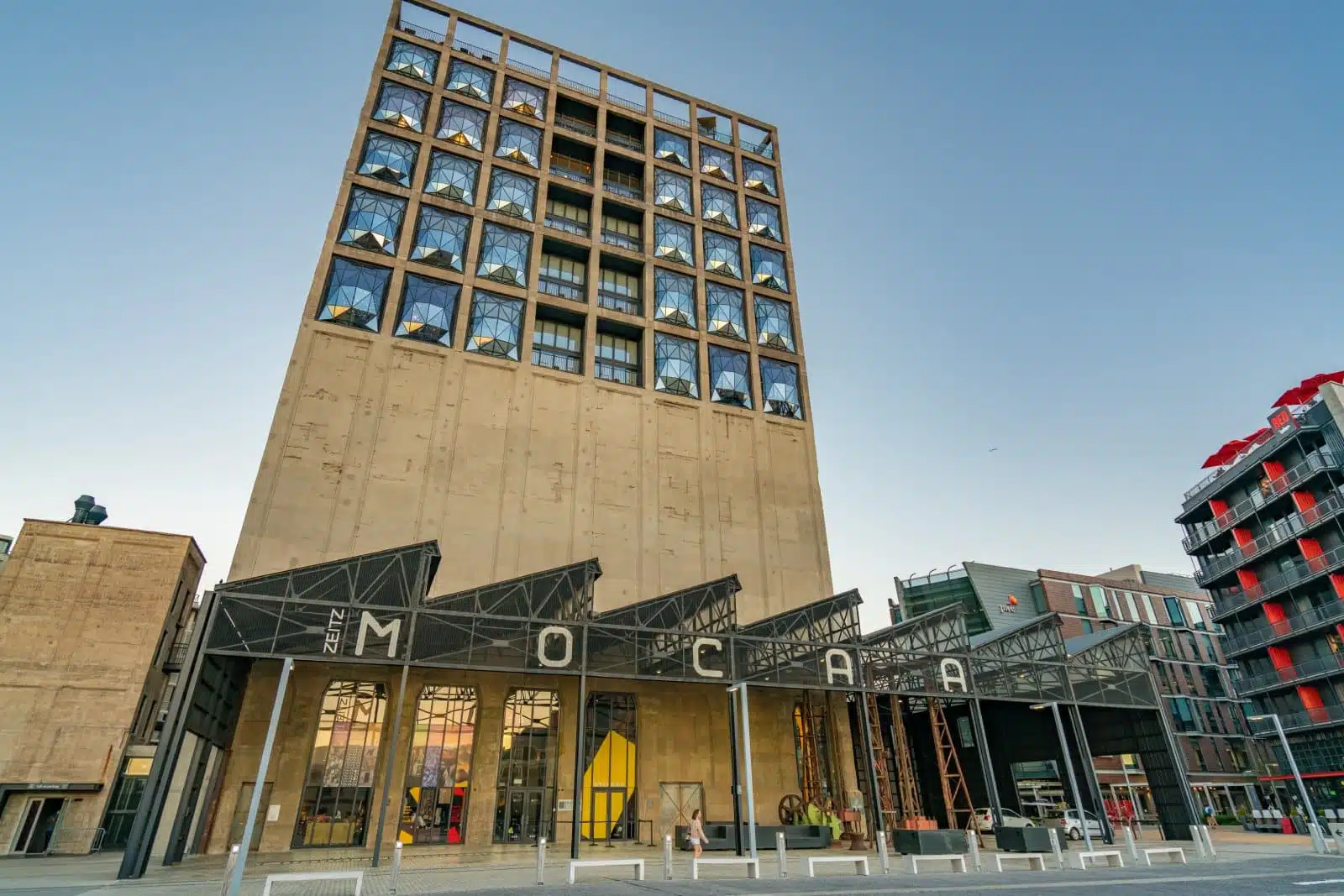
Image Credit: Shutterstock / NoyanYalcin
The Zeitz Museum of Contemporary Art Africa (Zeitz MOCAA), housed in a converted grain silo at the V&A Waterfront, is a pioneering institution dedicated to collecting, preserving, and exhibiting cutting-edge contemporary art from Africa and its Diaspora. The museum’s architecture retains historical elements of the silo while incorporating modern design to create an impressive space that spans nine floors. Zeitz MOCAA features a permanent collection and temporary exhibitions that showcase diverse artistic mediums and perspectives, highlighting the dynamic and evolving nature of contemporary African art. The museum serves as a critical platform for African artists on the global stage and as an educational resource, offering workshops, lectures, and community programs. Zeitz MOCAA represents a significant cultural milestone for Cape Town and the continent, affirming the city’s status as a key player in the international art scene and exploring the complexities and beauty of African identity and expression.
Insider’s Tip: Don’t miss the opportunity to explore the museum’s unique architecture. The building itself is a work of art, offering incredible views from its upper levels.
When to Travel: The museum is open year-round, but visiting during the week can help avoid the crowds that gather on weekends.
How to Get There: Zeitz MOCAA is located in the Silo District of the V&A Waterfront, easily accessible on foot from many parts of the waterfront, or by car, taxi, and public transport from elsewhere in Cape Town.
The Bottom Line

Image Credit: Shutterstock / Sergey Uryadnikov
Cape Town is a city of unparalleled beauty, rich history, and vibrant culture. From the serene beaches of Clifton to the historic significance of Robben Island, each destination offers a unique insight into the heart and soul of this magnificent city. Whether exploring the natural wonders, engaging with the art and culture, or simply soaking in the breathtaking views, Cape Town promises an unforgettable experience. Embrace the adventure, immerse yourself in the diversity, and let Cape Town reveal its many treasures.
More From The Green Voyage
Top 10 Trending Travel Destinations 2024
6 Essential Banking Apps for International Travel – Managing Your Finances on the Go
Traveling With Kids – 10 Tips to Create Memorable Family Holidays
The post A City Guide to Cape Town, South Africa first appeared on The Green Voyage.
Featured Image Credit: Shutterstock / PeopleImages.com – Yuri A.
For transparency, this content was partly developed with AI assistance and carefully curated by an experienced editor to be informative and ensure accuracy.
